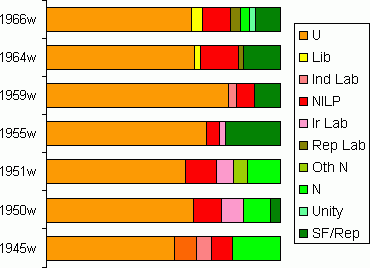

 |

|
| |
|
|
Thursday March 13, 2025
|
In Northern Ireland the Unionist government under Prime Minister Terence O’Neill continued to make economic reform a priority. Some of the key reforms included a new Economic Council under the chairmanship of the Minister for Commerce, Brian Faulkner, a new Development Ministry under William Craig, the commissioning of a Northern Ireland Economic Plan, and government recognition of the Irish Congress of Trade Unions. A major taboo was also broken during this period when O’Neill invited the Irish Taoiseach Sean Lemass to visit Northern Ireland. The meeting, which held political risk for both leaders, took place on January 14, 1965 at Stormont House. O’Neill had not informed his cabinet of the Taoiseach’s visit, summoning them only on the morning of the meeting. In the end only Harry West, the Minister of Agriculture, refused to meet Lemass.
O’Neill also garnered a certain amount of Catholic support during this time with a number of unprecedented gestures including visits to Catholic schools and hospitals, and meeting with Cardinal Conway in Armagh. Such was the impact that in 1965 the Nationalist Party agreed to become the official opposition at Stormont for the first time. However, this honeymoon period would soon give way to Catholic disillusionment at O’Neill’s inability to deliver deeper reform in the face of growing internal opposition. Catholic frustrations also grew out of the lack of sensitivity around such issues as the naming of the new city between Lurgan and Portadown after Craigavon, and the locating of a new university in Coleraine instead of Derry.
In the Westminster election, the Unionist Party won eleven of the twelve available seats and their percentage of their popular vote dropped slightly to 61.8% compared to 63% in 1964. The Republicans also saw there vote recede to 10.5%, this time contesting only five seats and facing competition from a Unity candidate in Fermanagh & South Tyrone and a Nationalist candidate in Londonderry. The NILP saw their vote slip to 12.2%, down almost 4% on their best ever result of 1964. However, the major story of the election was the victory of the colourful Gerry Fitt in West Belfast. Fitt, under the label of Republican Labour, successfully defeated the Unionist Party incumbent, James Kilfedder.

This map by Conal Kelly shows
the winner in each constituency in 1966.
| Party | Votes | % Share | Seats Won | |
| Unionist | 368,629 | 61.8% | 11 MPs | (Armagh
, East Belfast, Fermanagh & South Tyrone,
Londonderry, Mid Ulster,
North Antrim,
North Belfast, North Down, South Antrim, South Belfast and South Down) |
| NILP | 72,613 | 12.2% | ||
| Republican | 62,782 | 10.5% | (West Belfast) | |
| Liberal | 29,109 | 4.9% | ||
| Republican Labour | 26,292 | 4.4% | 1 MP | |
| Nationalist | 22,167 | 3.7% | ||
| Unity | 14,645 | 2.5% |

Other sites based at ARK: ORB (Online Research Bank) | CAIN (Conflict Archive on the INternet) | Northern Ireland Life and Times Survey
Your comments, please! Send
an email to me at nicholas.whyte@gmail.com.
Conal Kelly, 1 June 2007.
|
|
Disclaimer:©
Nicholas Whyte 2005 Last Updated on Saturday, May 07, 2005 09:42:49
|